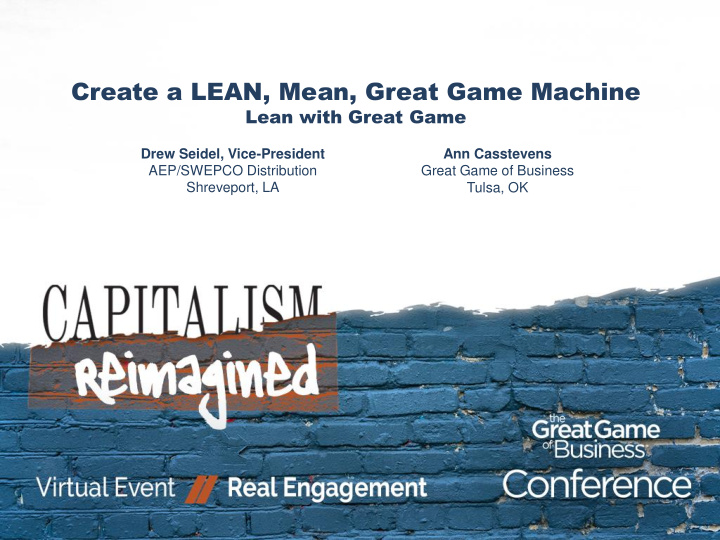



Create a LEAN, Mean, Great Game Machine Lean with Great Game Drew Seidel, Vice-President Ann Casstevens AEP/SWEPCO Distribution Great Game of Business Shreveport, LA Tulsa, OK
Getting to Know YOU!! Pla Playin ing the the Gam Game Ind Industry
Welcome
Meet Drew Seidel • Vice President, AEP/Southwestern Electric Power Company Distribution • 28 Years in the Electric Utility Industry • Generation & Distribution experience • Playing the Game - 25 years • Internal Coach – supported 25+ implementations • All-Star Champion Award 2014
American Electric Power
service territory
Getting to Know YOU!! Pla Playin ing the the Gam Game Ind Industry
Overview 1. Human Performance • How we interact and treat employees 2. Open Book Management / Great Game • Teaches us the Business 3. Lean / Continuous Improvement • Process & Tools to Solve Problems
Human Performance 5 principles 1. People Make Mistakes 2. Blame Fixes Nothing 3. Learning and Improving is Vital 4. Context Drives Behavior 5. How You Respond to Failure Matters
What is Open-Book ? (Great Game)
When Employees Think, Act & Feel Like Owners (Great Game)
Principles of the Game
Practices of the Game • Opening the Books & Teaching the Numbers • Focusing on the Critical Number • Acting on the Right Drivers • Keeping Score • Follow the Action – Huddles & Forward Forecasting
Focusing on the Critical Number & Acting on the Right Drivers Company Critical Number Department Workgroup Team Individual
Work as Planned vs. Work in Practice Normally Successful! “Masters of the (Conklin / Edwards) blue line”
The Plan/Targets vs. Variances to the Plan/Targets Normally Successful! “Masters of the (Conklin / Edwards) blue line”
How do people typically react to failure? Scapegoat
Human Performance 5 principles • People Make Mistakes • Blame Fixes Nothing • Learning and Improving is Vital • Context Drives Behavior • How You Respond to Failure Matters
The Pressure to Fix . . . . . . Outweighs the Desire to Learn! Effective Learning Learning Information Curve Better Solutions Respond and Contain Time Event (Edwards)
Learn and then Improve
Bob Edwards, The H.O.P. Coach
If we want better answers . . . we have to ask better questions!
When we believe we know the answer . . . . . . we stop asking questions . . . we stop listening . . . we stop learning!
The power to ask the right questions . . . . . . comes from acknowledging that you don’t know the right answer.
Until you’ve reached a point of understanding . . . . . . you are not done learning!
Learning Team Example Questions • What could have happened? • What worked well? • What surprised us? • How did our system set us up for failure? • What happened the way you thought it would? • Where did you have to ‘make do’, or adapt? • What made the work different to other work?
Start back in process . . . . . . move towards the event. Weak Signals Production pressure Unclear Signals Adaptation Fear of reporting Latent Conditions System Strengths System Weaknesses Errors Resource constraints Hazards & Risks Surprises Event Local Factors Flawed processes Personal Factors Incomplete Procedures Normal Variability Change in plans Near Misses No Surprise! Past Success Data Design shortcomings Poor communication Goal Conflict Tradeoffs (Conklin/Edwards/Baker/Howe)
(Edwards / Pearson)
Continuous Improvement Experience Wha hat Tools? Co Contin inuous Im Improvement Exp xperie ience
What is Lean • Process improvement methodology designed to • Eliminate problems • Remove waste and inefficiency • Improve working conditions to provide a better response to customers’ needs
Working Well ll Try Stor Try tormin ing Le Learnin ing Problem Mic icro- Team Experimenta tation Kai aizen Valu Va lue Stre tream Anal alysis (V (VSA)
Complex Problem A3 A3 Learning Problem Team VSA SA Min ini Kai Kaizen Gam Game Working Well ll
Vegetation Management
Admin Group
learning makes a difference.. • In order to solve a problem you have to first understand the problem. • Learning Teams uncover what our process is today (VSA) • Gives you the blue line story • Makes complexity transparent • Find out what the real issues are people are dealing with everyday
Tying it all together… 1. Human Performance • How will we interact and treat employees 2. Open Book Management / Great Game • Teaches us the Business 3. Lean / Continuous Improvement • Process & Tools to Solve Problems
references • Bob Edwards - The HOP Coach, Learning Teams • Tim Kight, Above the Line, Focus 3 • The Great Game of Business • Senn Delaney, Winning Teams Winning Culture • Todd Conklin, Pre-Accident Investigations, Better Questions
QUESTIONS
Recommend
More recommend